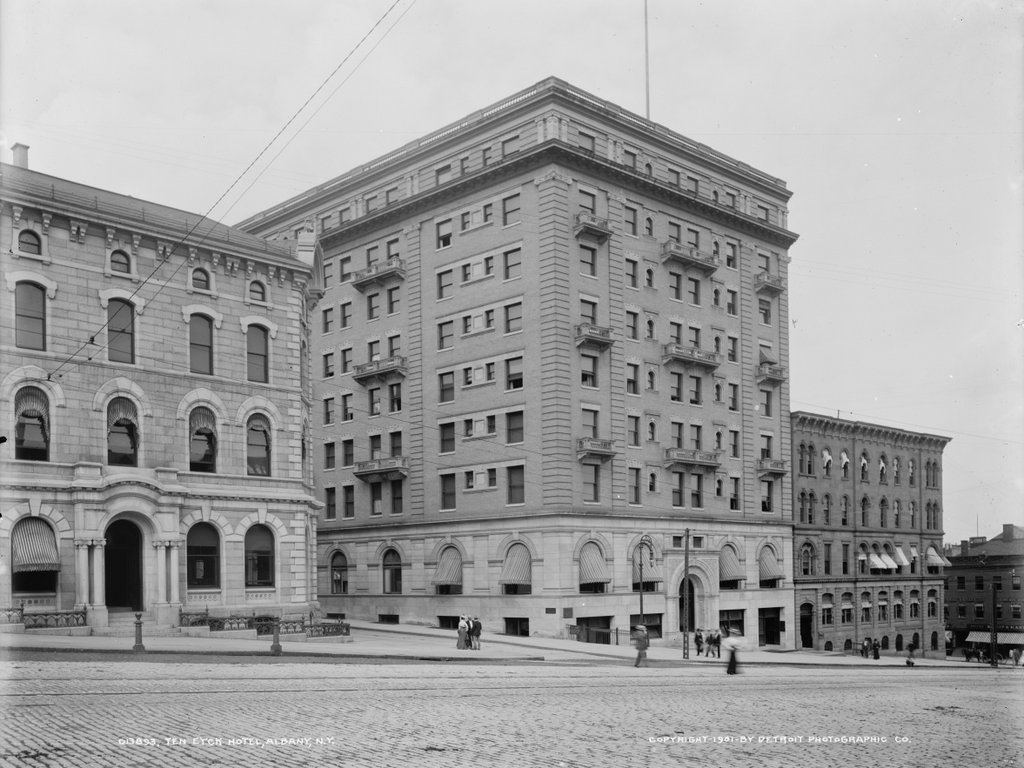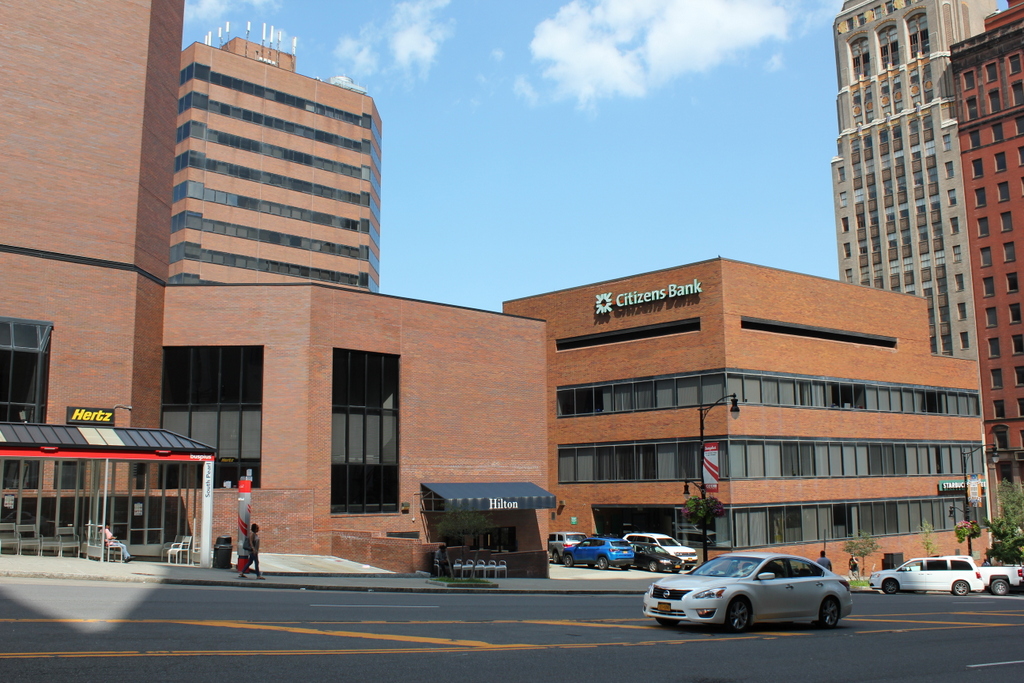The Ten Eyck Hotel, seen from the corner of State and Chapel Streets in Albany, around 1901. Image courtesy of the Library of Congress, Detroit Publishing Company Collection.
The scene in 2019:
The Ten Eyck Hotel was one of Albany’s leading hotels of the early 20th century. It was built in two different stages, but the oldest section of the building, which is shown here in the first photo, was completed in 1899 at the northeast corner of State and Chapel Streets. It was named for James Ten Eyck, a local businessman whose family traced back to the early years of the Dutch settlement in Albany. He was part of the ownership group that built the hotel, and he was also its first official guest, signing his name in the register as part of the hotel’s opening on May 8, 1899.
The Ten Eyck was built in order to meet the demand for a new hotel in Albany. The city’s famous Delavan House had burned in 1894, and 16 people died in the fire. Hiram J. and Frederick W. Rockwell, the father-and-son partnership that ran the Kenmore Hotel, recognized the need for a new hotel, and they helped to form the Albany Hotel Corporation, which was established in 1897 with James Ten Eyck as one of its directors. Work on the new building began in 1898, and upon completion the Rockwells signed a long term lease to operate the hotel.
At nine stories in height, the Ten Eyck towered above its neighbors here on the north side of State Street, as shown in the 1904 photo in a previous post. The eastern side of the hotel, which is visible in that photo, was unadorned brick, but it did feature a large painted advertisement that declared the Ten Eyck to be “positively fire proof.” This fact was touted in contemporary print advertisements as well, likely in order to assure customers that it would not suffer the same fate as the Delavan, whose fire was still in recent memory.
The first photo here was taken only about two years after the Ten Eyck opened. At the time, the hotel was flanked by two older, smaller commercial blocks. On the left side of the photo is the ornate Albany Savings Bank building, which was completed in 1875. However, by the time the photo was taken, the bank had moved to a new facility on North Pearl Street, and this building here on State Street was repurposed as county offices. Directly adjacent to the hotel, on the right side of the photo, is the Tweddle Building. It was built in the mid-1880s, replacing the earlier Tweddle Hall that had burned in 1883, and it featured a mix of commercial offices and retail space.
The Ten Eyck proved to be popular, and in the mid-1910s the owners embarked on a massive expansion project. They purchased the Tweddle Building, demolished it, and constructed a new 17-story hotel building, which opened in 1917. The older nine-story section became the Ten Eyck Hotel Annex, and together these two buildings were used by the hotel for many years.
Throughout the first half of the 20th century, the Ten Eyck remained one of the city’s most popular hotels. It changed ownership several times, eventually becoming a Sheraton, but by the 1960s it had begun to decline. This was the case in cities across the northeast, where once-fashionable downtown hotels were losing business to newer suburban hotels and motels. A major part of this was because of companies moving away from downtown locations, and also because of changes in transportation patterns. With most people now traveling by car instead of by train, it was much easier to stay at a modern hotel right off the highway rather than navigating downtown traffic to reach places like the aging Ten Eyck.
As a result, the Ten Eyck closed in 1968, and both buildings were demolished several years later. The old Albany Savings Bank on the left side of the photo appears to have been demolished around the same time, and the entire two-block section between North Pearl and Lodge Streets was redeveloped. Now completely unrecognizable from the first photo, this scene features several modern buildings, including an office building on the right and a Hilton hotel on the left.



Obviously, Albany is so much the poorer for the loss of this architecture, including beautiful buildings shown in other posts. Even so, the city still neglects its heritage as evidenced by so many heartbreaking, decaying structures all around the city. And it’s a double shame that what replaces the old, in every single case is at best mediocre, but mostly ugly. Truth be told. Should be apparent to all we are a nation in decline when we can’t even maintain our own architectural heritage and nothing new is remarkable. You want to know how things are going in America? Just take a look around, the place is a shambles.
You could say the same about Boston more so than Albany. But Boston has progress where Albany has a historic preservation that thinks old equals historic. The truth is a lot of buildings in Albany were not great when they were built and didn’t get better with time.
Yes, save the truly historic. Bulldoze the rest.
A 40 foot dog isn’t historic. An old ice warehouse isn’t historic.
Historic preservation works best on a large scale, not just a few isolated buildings here and there. Boston is actually a great example of that, with well-preserved neighborhoods like the North End, Beacon Hill, Back Bay, and South End. The historic character of these areas is probably part of the reason why Boston is becoming such a desirable place to live, while Albany is . . . Albany.
Some see the total opposite.
I remember when the Ten Eyck hotel was demolished and I know where they dumped it. As kid my mom worked at what was The Lepore Motel (Long Gone) off Rt 9 & 20 in East Greenbush. A pond was behind the motel and that’s where the Ten Eyck was dumped. I watched truck load after truck load dump into that pond. It never filled in the pond, just created an island still visible to this day.
Please don’t forget the people who worked at this hotel to keep it running. My grandmother worked at this hotel. Never forget the hard workers.
I never will. My dad worked there for many years right up to its closing.
My father was the restaurant manager in the Walgreens on the ground floor of the Ten Eyck from 1955 until it closed. Enter through that heavy wood framed revolving door!
I have a giant sign from the ten eyck building FOR SALE it says DOLLIWOG LOUNGE … EMAIL ME FOR Picture AND DETAILS FRANKBRINO@HOTMAIL.COM
I was pleased to find that the 40 foot bar from the Ten Eyck was saved and relocated to the Depot Grille in Staunton, Virginia where I now live. So happy that at least a piece of this historical building was not destroyed.
Stopped for dinner at the Depot Grill in Staunton VA tonight on my way home to Saratoga NY. I was amazed to learn that the entire bar marble elbows rest & super large carved back bar had been salvaged from the Albany Ten Eyck Hotel & shipped to Staunton in 1990 at the time the old train station was repurposed as a restaurant according to the manager whom I
spoke with.
I can’t believe no one in Albany bought it kept it from leaving town. What a treasure, what a shame!
My seventh great grandpa and all of his children brought this place into existence. I was kind of hoping it still existed so I could get some more background. But can’t stop “progress”. The only idea I have of what their lives in Albany were like are Jacob Ten Eyck’s silver exhibits in the Metropolitan Musuem.
My parents stayed there in 1943. I still have some very stylish Ten Eyck menus from that period but I am not sure what to do with them.
A shrimp cocktail, Chicken okra Creole soup, a boiled lobster, and a baked Alaska dessert for $5.15?
Anyone?
We have pictures of my husband’s father and mother on what looks like tin or lead frames “Taken by the Photomatic International Mutoscope Reel Co., Inc. New York City”. Kind of like a photo booth! We think they’re circa 1938.